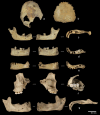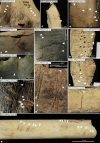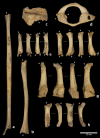Evidence of neolithic cannibalism among farming communities at El Mirador cave, Sierra de Atapuerca, Spain
- PMID: 40774979
- PMCID: PMC12331932
- DOI: 10.1038/s41598-025-10266-w
Evidence of neolithic cannibalism among farming communities at El Mirador cave, Sierra de Atapuerca, Spain
Abstract
In El Mirador cave in Sierra de Atapuerca, Spain, a unique collection of human remains provides insights into cannibalistic practices from the Neolithic to the Bronze Age. Six Early Bronze Age individuals (4600-4100 cal BP) showing signs of cannibalism were discovered in the early 2000s. Later excavations uncovered older remains with similar cultural modifications. A Bayesian statistical analysis of the radiocarbon dates identified a single earlier event (5709-5573 cal BP) unrelated to the Bronze Age finds. 87Sr/86Sr analysis showed the cannibalised people were of local origin. The episode coincided with the end of the Neolithic occupation, suggesting this was a not common behaviour among the cave inhabitants. Given the age of the cannibalised individuals and environmental conditions, the data does not indicate a response to famine. This study complements and expands upon our understanding of European prehistoric cannibalism. The current findings suggest that cannibalism may be linked to intergroup violence during late prehistoric periods.
© 2025. The Author(s).
Conflict of interest statement
Declarations. Competing interests: The authors declare no competing interests.
Figures






References
-
- Weiss-Krejci, E. The formation of Mortuary deposits. In Social Bioarchaeology (eds. Agarwal, S.C & Glencross, B. A.) 68–106 (Wiley-Blackwell, 2011).
-
- Garrido, R., Rojo, M., Tejedor, C. & García-Martínez, I. Las máscaras de la muerte: ritos funerarios en el Neolítico de la Península Ibérica. in El Neolítico en la Península Ibérica y su contexto europeo (eds. Rojo Guerra, M., Garrido Pena, R. & García Martínez de Lagrán, I.) 143–174 (2012).
-
- Blasco, A., Edo, M., Villalba, M. J. & Saña, M. Primeros datos sobre la utilización sepulcral de la Cueva de Can Sadurní (Begues, Baix Llobregat) en el Neolítico Cardial. in III Congreso del Neolítico en la Península Ibérica (eds. Arias, P., Ontañon, R. & García-Moncó, C.) 867–878 (2005).
-
- Varela-Gomes, M. Castelo Belinho (Algarve): a ritualização funerária em meados do V milénio AC. in Os últimos caçadores-recolectores e as primeiras comunidades produtoras do sul da Península Ibérica e do norte de Marrocos: actas do workshop (Faro 2–4 Novembro de 2009) (eds. Gibaja, J. F. & Carvalho, A. F.) 69–79 (Universidade do Algarve Faro, 2010).
-
- Molist, M. et al. Los orígenes del megalitismo en Cataluña en el marco de las prácticas funerarias del Neolítico. in Actas del Congreso Internacional sobre Megalitismo y otras manifestaciones funerarias contemporáneas en su contexto sociconómico y cultural. Munibe (suplemento) (eds. Fernández-Eraso, J. & Mujika, J. A.) vol. 32 212–224 (2010).
Publication types
MeSH terms
Grants and funding
- PID2021-122355NB-C32/Ministerio de Ciencia, Innovación y Universidades
- PID2021-122355NB-C32/Ministerio de Ciencia, Innovación y Universidades
- PID2021-122355NB-C32/Ministerio de Ciencia, Innovación y Universidades
- PID2021-122355NB-C32/Ministerio de Ciencia, Innovación y Universidades
- PID2021-122355NB-C32/Ministerio de Ciencia, Innovación y Universidades
- PID2021-122355NB-C32/Ministerio de Ciencia, Innovación y Universidades
- PID2021-122355NB-C32/Ministerio de Ciencia, Innovación y Universidades
- PID2021-122355NB-C32/Ministerio de Ciencia, Innovación y Universidades
- PID2021-122355NB-C32/Ministerio de Ciencia, Innovación y Universidades
- PID2021-122355NB-C32/Ministerio de Ciencia, Innovación y Universidades
- PID2021-122355NB-C32/Ministerio de Ciencia, Innovación y Universidades
- PID2021-122355NB-C32/Ministerio de Ciencia, Innovación y Universidades
- PID2021-122355NB-C32/Ministerio de Ciencia, Innovación y Universidades
- PID2021-122355NB-C32/Ministerio de Ciencia, Innovación y Universidades
- SGR2021-01239/Generalitat de Catalunya
- SGR2021-01239/Generalitat de Catalunya
- SGR2021-01239/Generalitat de Catalunya
- SGR2021-01239/Generalitat de Catalunya
- SGR2021-01237/Generalitat de Catalunya
- SGR2021-01239/Generalitat de Catalunya
- SGR2021-01239/Generalitat de Catalunya
- SGR2021-01237/Generalitat de Catalunya
- SGR2021-01237/Generalitat de Catalunya
- SGR2021-01237/Generalitat de Catalunya
- SGR2021-01239/Generalitat de Catalunya
- 2022PFR-URV-64/Universitat Rovira i Virgili
- 2022PFR-URV-64/Universitat Rovira i Virgili
- 2022PFR-URV-64/Universitat Rovira i Virgili
- 2022PFR-URV-64/Universitat Rovira i Virgili
- 2022PFR-URV-64/Universitat Rovira i Virgili
- 2022PFR-URV-64/Universitat Rovira i Virgili
- 2022PFR-URV-64/Universitat Rovira i Virgili
- 2022PFR-URV-64/Universitat Rovira i Virgili
- 2022PFR-URV-64/Universitat Rovira i Virgili
- 2022PFR-URV-64/Universitat Rovira i Virgili
LinkOut - more resources
Full Text Sources

